We are reader supported. When you purchase through links on our site, we may earn an affiliate commission. Also, as an Amazon affiliate, we earn from qualifying purchases.
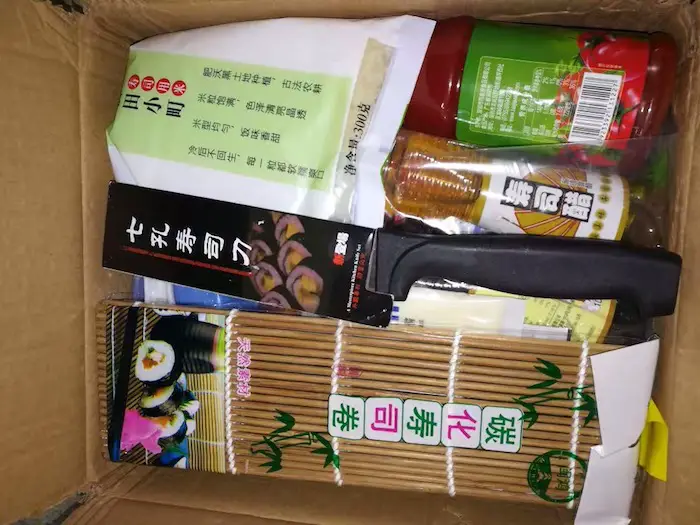
There was a time when I craved for sushi almost every other day as it was such as exotic delicacy that looked eluding to me. But, every time I would think of heading to the restaurant, my purse cried out loud and tried to stop me in all possible ways. No wonder, dining frequently at classy sushi restaurant was not a good idea for someone who had just started his career.
During that time, I started learning how to make sushi at home to save making repeated trips to the restaurant and still satisfy my cravings. Interestingly, it not only turned into an enjoyable passion but I also learned to make different varieties of sushi with combinations you may not get in a restaurant.
If you are in a similar situation like I was several years ago, I would recommend you to start learning how to make sushi at home. You will need to buy a few essential tools to get started and this will more than compensate for your lack of experience. With these tools, you will be able to start making different types of sushi in no time.
Contents
Sushi Rice
Perfect sushi starts with sushi rice (See Amazon) and it is one of the first things you need to know. To a beginner, sushi may look easy with just a glob of rice and a fish on the top, or rice, fish, and veggies rolled inside a Nori sheet. However, a lot of patience and practice goes into making the perfect sushi rice.
When learning at home, you can take some liberty with the consistency and it will taste good anyway, although not restaurant-like. So, the first thing you will need to buy is the sushi rice. Not any variety of rice will do. You will need to purchase only the best quality Japanese short grain rice, also known as Japonica rice or uruchimai.
Short grain rice is known for its plump size and sticky texture that makes it stands out. It is capable of retaining more moisture and is stickier than many other varieties out there. When deciding which brand of short grain rice to buy, some things to consider include – sweetness, freshness, texture, flavor, stickiness, and place of production.
You must always ask for the shinmai variety, which is the newest crop when looking for the best quality sushi rice brand in the grocery store or online.
Rice Cooker
While you can cook rice in a pan, an electric cooker can give you the most consistent results, especially if you are a beginner. When looking for a rice cooker, you will find different types of models and features to choose from. Some common types are – induction rice cookers, conventional electric, and induction pressure cookers.
If you are considering to buy a rice cooker (see my reviews) specifically for making sushi at home then make sure it has umami settings to help you get the right flavors. You should also consider the capacity of sushi rice you would usually make at a time and how frequently you will be cooking rice.
Zojirushi is one of the best brands for rice cookers and I would recommend the induction-plus-pressure model for those who have several other uses of the cooker in the kitchen. However, if you wish to save some counter space, you may check out some of the electric rice cooker brands such as Staub rice cooker and so on.
Rice Cooking Pot
In the average American kitchen where rice is not a staple food, investing in an electric cooker may not be a wise decision in terms of finances and space available. For such consumers, a rice cooking pot can be a good option as it can also be used for various other things.
Mesh Strainer
Whether you cook sushi rice in an electric cooker or pot, a mesh strainer like this can come handy to help you get the best results. After rinsing rice properly, you need to drain the excess water using a mesh strainer with small holes.
Instead of leaving warm rice inside the pot or cooker, transfer it to a mesh strainer to remove any water and then let it cool in a large bowl.
Bamboo Rice Paddle
Bamboo rice paddle is one of the essential tools for making sushi at home as it aids in cooling down the cooked sushi rice. This is an important step that prevents your rice from becoming too sticky. The paddle is also used for removing the rice from the cooker and mixing up rice while seasoning it in the hangiri.
As the bamboo rice paddle is non-metal, it does not react with the rice vinegar or influence the taste of rice in any way. It also does not impact the non-stick properties of the cooker. You can find good quality bamboo rice paddle is an Asian grocery store or online.
Tip: Make sure you never put your bamboo rice paddle inside the dishwasher as this can destroy the product.
Sushi Oke/ Hangiri
This may not be a dire necessity for making sushi, however, it comes handy for cooling and mixing sushi rice with vinegar. These are shallow flat-bottomed pans that are made from a variety of Japanese cypress called hinoki. The hangiri should be soaked in water before using.
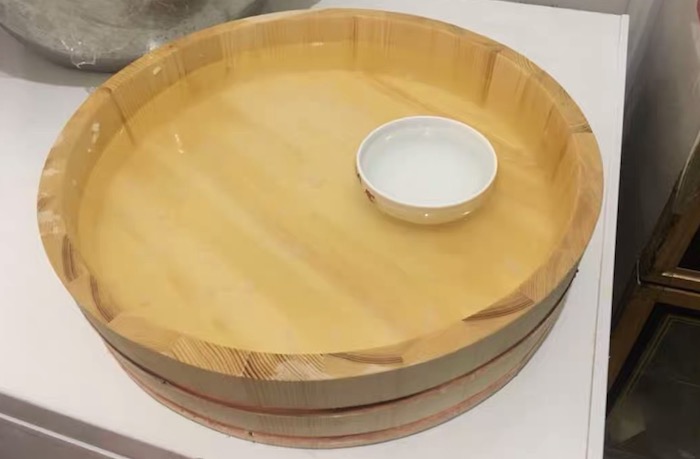
After the sushi rice is cooked, it is spread out in the hangiri to cool down and then mixed with vinegar solution using a bamboo paddle. It is then covered with a towel to prevent the rice from drying out. The wooden bowl helps in absorbing the excess moisture and makes the rice perfectly fluffy for making sushi.
The large surface area of the hangiri comes as a great tool for cooling sushi rice. It works best for those who make rice frequently. Oke/ hangiri can be purchased from an Asian grocery store or you may also buy online from Amazon.
Rice Vinegar
Seasoning sushi rice is an essential step in flavoring the sushi rice. After sushi rice is cooled, it is mixed with rice vinegar, sugar and salt to enhance the taste. You can find rice vinegar in an Asian grocery store near you or purchase online.
Soy Sauce
Sushi will not smell or taste like one without the soy sauce, an essential condiment for this Japanese delicacy. You may find it in any grocery store near you or buy online from Amazon.
Wasabi
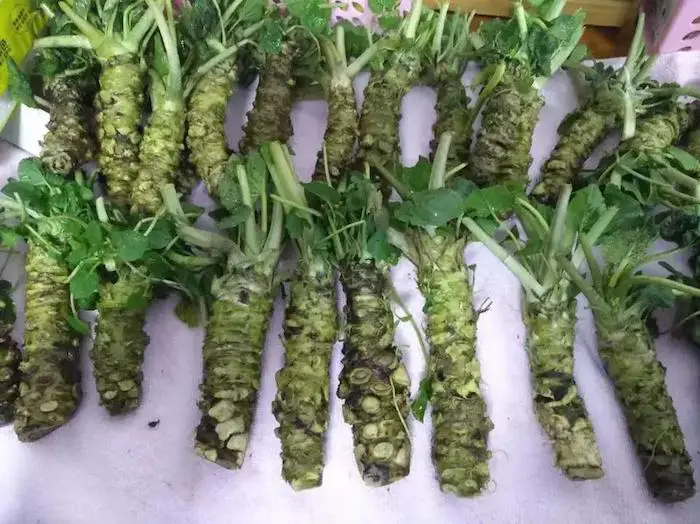
I like referring to this condiment as the nasal passage-clearing sauce because its heat can clear up a stuffed nose. Most of the wasabi pastes today are not made of real wasabi and is substituted by Japanese horseradish instead. However, you can look for the authentic wasabi root online.
Japanese Shark Skin Grater
If you are lucky enough to find a real wasabi root, you will need the perfect grater to make the paste. I recommend this Japanese Shark Skin Grater that is capable of pulling out the authentic flavor and taste from wasabi. Most of these products are made in Japan and you can buy them online.
Pro tip – Make sure you consume the wasabi paste immediately after grating it because it tends to lose flavor after some time.
Pickled Ginger
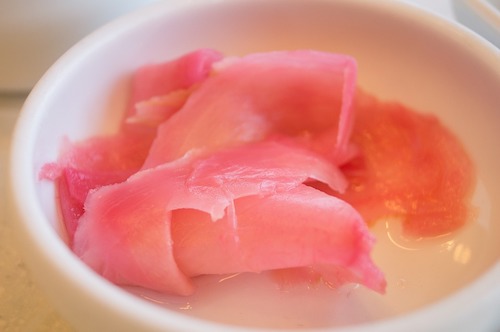
If you are a sushi fan, you will know that pickled ginger has an important role to play in a sushi meal. It is used as a palate cleanser and is usually eaten in small quantity between sushi bites to be able to enjoy the taste of different varieties of raw fish.
Pickled ginger is made from young ginger roots and when fresh, they may have a light pinkish tint to it. However, some manufacturers may add colors to make the ginger look deep pink to attract customers. You can find pickled ginger at a grocery store or find links on my favorite ingredients page.
Gyuto knife
When making sushi, you cannot do without a good sushi knife and a gyuto or chef’s knife is a must-have if you have the passion to cook restaurant-like. Also known as the French knife or cook’s knife, it is one of the most versatile knives found in the Western kitchen.
In the Japanese kitchen too, it can be as versatile and used for cutting vegetables, filleting fish, and slicing sushi rolls and sashimi. For making sushi, a gyuto knife is more recommended that other specialized knives such as usuba, deba, and yanagiba.
The gyuto knife may not do specific jobs like a Japanese traditional knife, but it works fine for making sushi at home. It usually ranges from 6 to 14 inches, however, I would recommend an 8-10 inch knife for multipurpose use. You can see my previous reviews here.
Slicing knife
Making sushi involves a lot of slicing and dicing, from making thin fish fillets to cutting vegetables and fruits. If you are a sushi fanatic who likes to experiment with different recipes and enjoy sushi for dinner several times a week, you will need a sujihiki or slicing knife.
This is a thin, long, and double-edged knife that works more efficiently than the traditional yanagiba knife. Besides cutting vegetables into thin slices, you may also use them to cut sashimi slices or make equal sushi pieces in just a long stroke.
Pro tip – When looking for a sharp sushi knife to make slices, you must ensure that it is 8 inches long, however, 10 or 12 inches are also acceptable.
Bamboo Mat
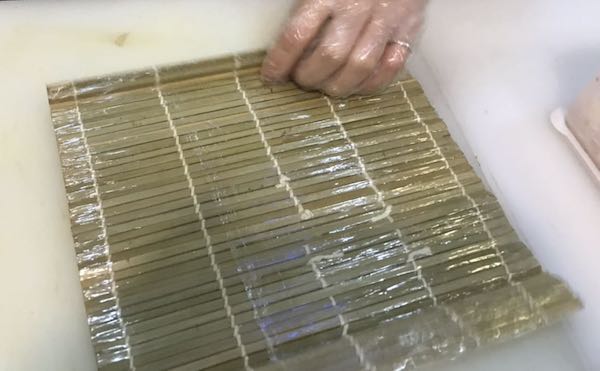
If you are not onto using sushi making kits and believe in making freestyle hand rolls, a bamboo sushi mat(see my favorite one) is a must-have. Some people are of the opinion that the name ‘maki rolls’ is inspired by the Japanese term for bamboo mat – makisu.
These mats are basically woven mats made of cotton string or bamboo material. Most of the commonly used makisu is made with thin or thick pieces of bamboo. To roll sushi, you must look for the thin versions. While there are many synthetic mats available claiming to deliver good results at rolling sushi, the bamboo mats are much more inexpensive and useful.
You must always clean the bamboo mat after making a traditional roll to prevent the build-up of bacteria due to food particles getting stuck in the mat. When making an inside-out roll, you must cover the bamboo mat in plastic wrap to prevent the rice from sticking to it.
Plating Chopsticks
While I would not really call this an essential tool for sushi making, plating chopsticks work like tweezers for delicate plating. These chopsticks are made of metal and they have wooden handles. Unlike the ones used for eating, these chopsticks have sharp points and they are used for hygienically decorating the sushi pieces.
If you are a sushi perfectionist who loves to experiment with different recipes and achieve a restaurant like finesse, this tool is a must-have. You can find them at an Asian store near you or buy them online.
Seaweed Sheets (Nori)
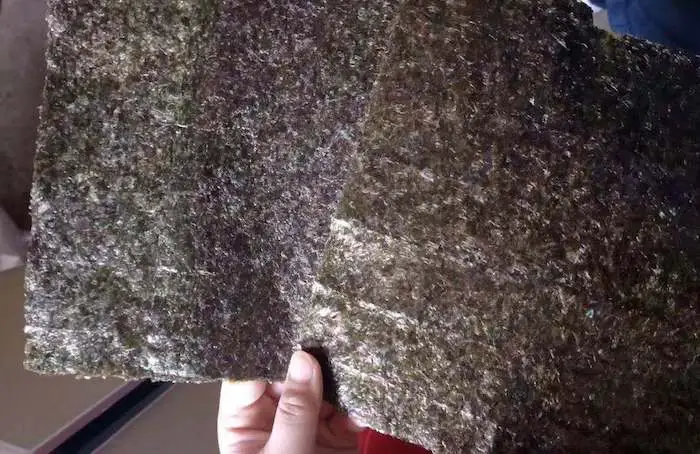
The greenish-black seaweed or Nori sheets are used for making traditional maki rolls. They are often roasted to add extra crispiness to the rolls. Nori sheets are extremely nutritious and they may be cut into half or quarter size as per your requirements. Besides being used as an outside or inside wrap in sushi rolls, they may also be used in miso soup or rice bowls.
The good quality Nori sheets will be slightly thicker and have a deeper hue. They will have a solid texture without too many holes. You can find Nori sheets at a grocery store or buy them online. After you have opened the package, transfer the unused sheets into an airtight container or zip lock bag to retain the freshness.
Sushi Making Kits
There was a time when people had no option but give up the thought of making sushi at home if they couldn’t get a hang of how to roll, but not anymore. Today, you can find a plethora of sushi making kits that can help you get a perfect shape even if you are not an expert at it.
Most of them are extremely easy to use. You just need to open the tube, spray some oil into it to prevent the rice from sticking, add rice, make an impression with the rod, add fillings, close the rod to make a compact roll, cover it with a Nori sheet and make slices.
I have reviewed a few sushi making kits for you to make an informed choice. You may purchase from Amazon or an Asian store near you.
Oil Spritzer
Again not a very essential sushi making tool, but it comes handy when making sushi at home. It can also be used in various other ways while cooking. The advantage of using an oil spritzer is that it prevents excessive use of oil for healthy cooking.
The Sharpening Stone
If you are an ardent fan of sushi and love making sushi for dinner almost every weekend or more frequently, you will need a sharpening stone for the sushi knife. Given the fact that a sushi knife is not a cheap product, it is important to take good care and keep it well maintained.
With a Waterstone, you can sharpen your sushi knife at home to ensure optimum sharpness at all times. Read this article to know more about sushi knives and how to take good care of them.
Traditional Sushi Dinner Set
When you have all the essential tools for making sushi at home, nothing can stop you from enjoying the restaurant-like delicacy homemade. However, the presentation also plays an important role in enhancing the aesthetic value of the food served.
Consider buying a traditional sushi dinner set replete with serving plates, chopsticks and miso bowls to enhance your overall experience. Read reviews for some of the best Japanese sushi dinner sets available online.

